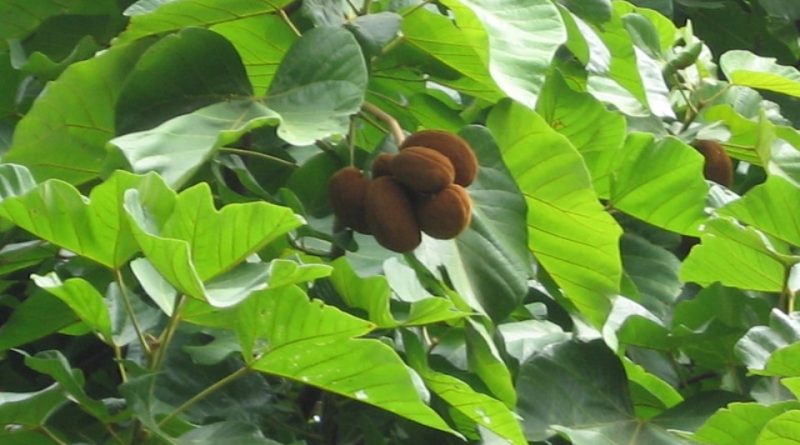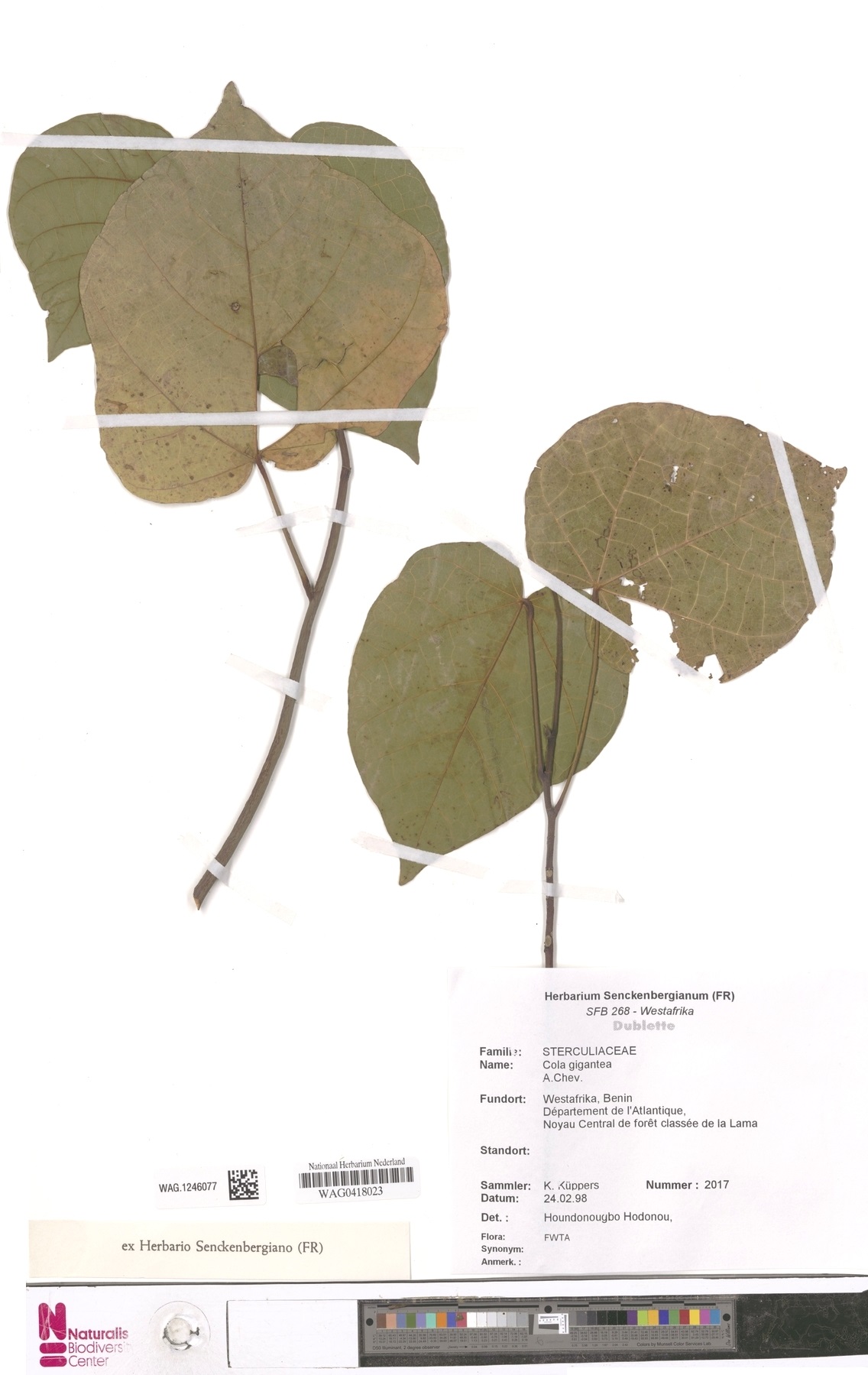Cola gigantea
Cola gigantea
The giant Cola (Cola gigantea A.Chev. 1908) is an arboreal species belonging to the Malvaceae family.
Systematic –
From a systematic point of view it belongs to:
Eukaryota domain,
Kingdom Plantae,
Division Magnoliophyta,
Class Magnoliopsida,
Subclass Dilleniidae,
Malvales Order,
Malvaceae family,
Subfamily Sterculioideae,
Cola genre,
Species C. gigantea.
The following varieties are recognized within this species:
– Cola gigantea var. gigantea;
– Cola gigantea var. glabrescens Brenan & Keay.
Etymology –
The term Cola derives from the Sudanese vernacular name kóla.
The specific epithet gigantea comes from the Greek γιγάνειος gigánteios, gigantic: due to its size, also in a relative sense, compared to other congeneric species.
Geographic Distribution and Habitat –
Cola gigantea is a plant native to tropical West Africa and in particular to an area that includes: Benin, Ivory Coast, Ghana, Nigeria and Togo.
Its natural habitat is that of savannahs and semi-deciduous forests, between 900 and 1500 m above sea level, where it often represents one of the dominant species.
Description –
Cola gigantea is a large evergreen tree that ranges from 20 to 50 meters in height and has a dense, spreading canopy with large leaves.
It has an erect trunk up to about 1.5 m in diameter, with gray or brown bark, vertically fissured.
The leaves, in young plants, are palmate with 3-5 lobes, about 45 cm long and wide, on a 4-20 cm long petiole; in adult plants these are ovate, 15-40 cm long and 10-35 cm wide, of a shiny green color above, covered by a white tomentum below; they have a rippled, lobed base with a wavy margin, alternating in a spiral on the branches.
The plant bears inflorescences 5-20 cm long, made up of numerous fragrant, unisexual flowers, without petals and made up of a bell-shaped calyx, 0.8 cm long and 0.6-1 cm in diameter, white in colour. tending towards pink over time, divided by 1/3 or more into 5 pointed lobes arranged perpendicular to the axis of the flower, with the external surface covered by a thick tomentum.
The fruits are dehiscent ovoid follicles, about 20 cm long and 16 cm in diameter.
Inside these there are ellipsoid-shaped seeds approximately 3.5 cm in length and 2 cm in diameter.
Cultivation –
Giant Cola is a plant that grows naturally in tropical West Africa and which, for cultivation, prefers full sun and performs well in plantations.
This plant becomes an imposing tree, fast growing and with large ornamental leaves, little known outside its areas of origin, but cultivable in tropical and subtropical climate regions in full sun and on a wide variety of soils; it is sometimes used as a shade tree or isolated specimen in large parks and gardens.
The plant reproduces by seed, which should be planted as soon as possible as it has a short-term germination potential; sowing must be carried out in an organic substrate with the addition of 30% sand or perlite, kept humid, at a temperature of 22-26 °C.
Reproduction can also take place by cutting.
Customs and Traditions –
Giant Cola is a plant known by various common names, including: giant cola (English); grand ouara (French); watapuo (Ghana).
Parts of this plant are often used in their places of origin to treat whooping cough, asthma, malaria and fever, as well as various diseases. The nut, high in caffeine, has a bitter taste. The bark is used medicinally to treat swelling, gout, leprosy or as a painkiller.
Recent studies have also highlighted the anti-inflammatory and antimicrobial properties of leaf extracts.
In the food sector, seeds are consumed locally in times of food shortage.
Among other uses, it is reported that the wood, white in colour, is of medium density and easy to work with, but has a relatively limited lifespan, which however can be increased by treating with appropriate preservative substances, usable in construction, for furniture and commonly used objects. and as a fuel, it also has characteristics suitable for use in paper production.
This tree was dedicated to Nelson Mendela of South Africa, to commemorate his visit to the Singapore Botanic Gardens in 1997. It was approved as a heritage tree in 2014.
Preparation Method –
Giant Cola is a plant used for both food and medicinal purposes.
In the food sector, seeds are consumed, especially in times of famine.
Bark, fruits and leaves have, however, been variously used since ancient times in traditional medicine for various pathologies; Recent studies have highlighted, among other things, the anti-inflammatory and antimicrobial properties of leaf extracts.
Guido Bissanti
Sources
– Acta Plantarum – Flora of the Italian Regions.
– Wikipedia, the free encyclopedia.
– GBIF, the Global Biodiversity Information Facility.
– Useful Tropical Plants Database.
– Conti F., Abbate G., Alessandrini A., Blasi C. (ed.), 2005. An annotated checklist of the Italian vascular flora, Palombi Editore.
– Pignatti S., 1982. Flora d’Italia, Edagricole, Bologna.
– Treben M., 2000. Health from the Lord’s Pharmacy, Advice and experiences with medicinal herbs, Ennsthaler Editore.
Photo source:
– http://www.westafricanplants.senckenberg.de/images/pictures/cola_gigantea_0037_ralfbiechele_386_c62049.jpg
– https://medialib.naturalis.nl/file/id/WAG.1246077/format/large
Attention: Pharmaceutical applications and food uses are indicated for informational purposes only, they do not represent in any way a medical prescription; we therefore decline any responsibility for their use for healing, aesthetic or food purposes.


